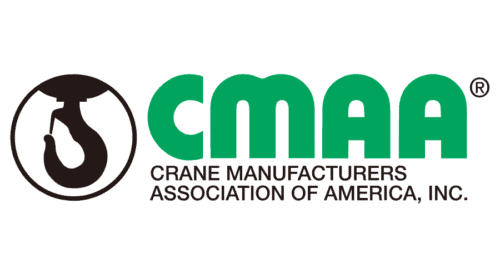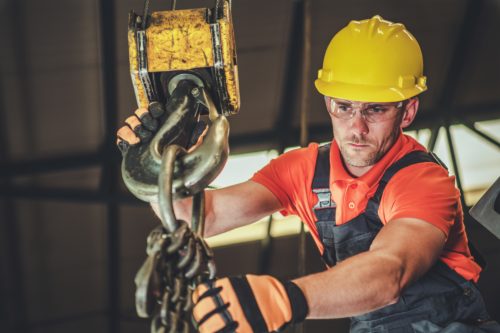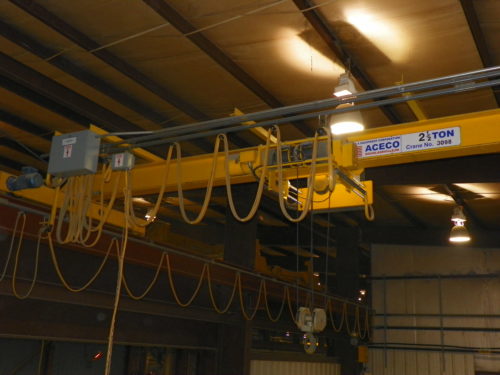Selecting the best crane or hoist equipment for your application is a challenging process. To find equipment that will facilitate safe and efficient operations, it is important to have a thorough understanding of crane terminology, different crane types, parts of a crane, and lifting terms. To help you, here is an overview of the top 12 terms you should know.
C.M.A.A
 C.M.A.A. refers to the Crane Manufacturers Association of America, an independent trade association that establishes and maintains quality and performance standards for electric overhead cranes. Established in 1927 as Electric Overhead Crane Institution, the C.M.A.A. is an internationally recognized authority for crane standards.
C.M.A.A. refers to the Crane Manufacturers Association of America, an independent trade association that establishes and maintains quality and performance standards for electric overhead cranes. Established in 1927 as Electric Overhead Crane Institution, the C.M.A.A. is an internationally recognized authority for crane standards.
Crane Boom
One of the most noticeable crane components is the boom. While a crane boom encompasses a variety of designs and features, it is fundamentally defined as the framework that supports and moves the load.
Critical Load
 Critical load refers to a load that requires additional control or support because it approaches the maximum weight capacity. If released or moved without adequate control, a critical load can severely compromise the safety of the system. Critical loads require the use of single failure proof cranes, which ensure adequate operational safety.
Critical load refers to a load that requires additional control or support because it approaches the maximum weight capacity. If released or moved without adequate control, a critical load can severely compromise the safety of the system. Critical loads require the use of single failure proof cranes, which ensure adequate operational safety.
Explosion Proof Crane
Explosion proof cranes are specifically designed to contain explosions and prevent heat or sparks from entering the surrounding workspace. They are used for applications where flammable and explosive materials are present, and they are typically divided into Class I, II, and III.
Class I is the most stringent, and these cranes are intended for applications where ignition of highly combustible materials and gases is likely, while Class II cranes are for potentially combustible airborne dust. Class III is the least strict, and these cranes are for applications with potentially ignitable airborne fibers.
Flux Vector Drive
A flux vector drive is a variable frequency drive that is used to monitor and control the speed and direction of the crane’s motor shaft. It allows for a greater degree of control over crane speed and braking by using a closed-loop system and adjustable incremental encoder to monitor the motor shaft during operation.
Hoist
The term “hoist” defines equipment that is used specifically for lifting and lowering loads. Hoisting, by its definition, is the act of raising a load on the vertical plane, and the term is often used in reference to the lifting applications of cranes.
Lift
For cranes, lift refers to the highest point to which a crane’s hook, magnet, or buck can lift a particular weight. Critical load calculations are used to define the lift of a given crane or hoist assembly, depending on the size and configuration of the crane and the weight of the load.
Load Block
Load block is the assembly of crane accessories suspended by the hoisting lines, which includes the hook, swivel, bearings, sheaves, pins, and frame. It is used to lift and move the load, and it monitors the tensile pressure to ensure that the loads remain within lifting capacity.
Overhead Crane
 An overhead crane is specifically designed to move heavy loads by operating from a fixed overhead structure. They can be operated using a mobile or stationary hoist and mobile bridge. Overhead cranes are available in a variety of designs and configurations.
An overhead crane is specifically designed to move heavy loads by operating from a fixed overhead structure. They can be operated using a mobile or stationary hoist and mobile bridge. Overhead cranes are available in a variety of designs and configurations.
Single Failure Proof
Single failure proof cranes are engineered to ensure that if one crane component fails, it will not cause the failure of another component within the system. This helps to secure the load, particularly in instances where load failure can have extremely negative effects.
Top Running Crane
Top running cranes are a type of overhead traveling crane that travels along rails supported by single or double girders with truck ends attached to runway support beams. They are capable of carrying loads without limiting capacity and are ideal for load-bearing applications in facilities with limited overhead space.
Wheelbase
The wheelbase of a crane or hoist refers to the distance from center to center of the outermost wheels, measured parallel to the support rail. This measurement can be used to determine carrying capacity.
Contact the Crane and Hoist Experts at American Crane
At American Crane, we have the knowledge and expertise necessary to help you find the perfect mobility solutions for your application. To learn how our crane and hoist equipment can improve your operations, contact us today or request a quote.





